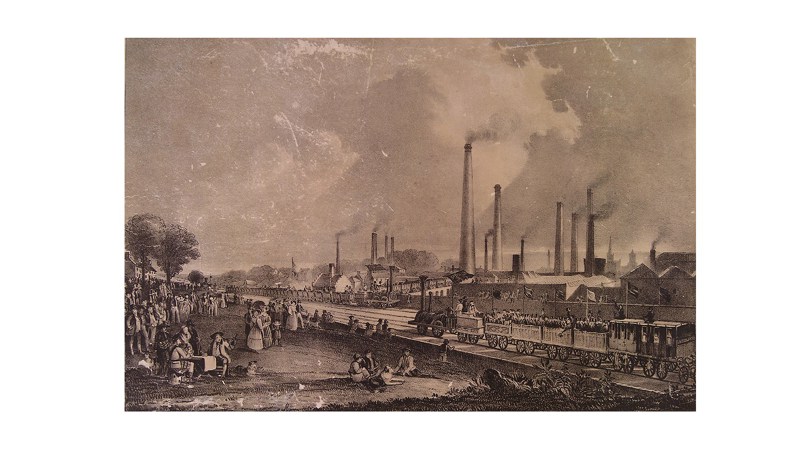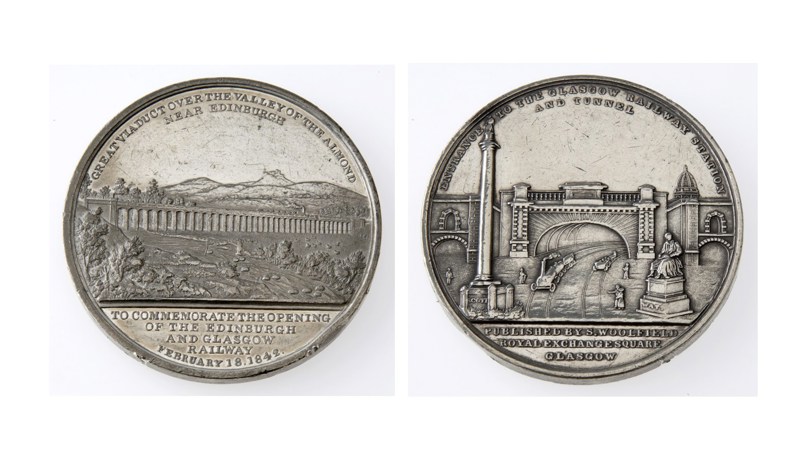Glasgow’s railways … funded by slavery?

Opening of the Glasgow and Garnkirk Railway
The opening of Scotland’s first railway was celebrated in a series of prints showing points along the line. Shown here is St Rollox chemical works to the north of Glasgow city centre. Picnickers watch the trains go by.
OG.1955.163.c
Images © CSG CIC Glasgow Museums Collection
1st December 2021
The 1830s saw an explosion of railway lines built up and down the length of Great Britain. The first to open for passengers and freight with a set time table was the Liverpool and Manchester Railway in 1830. Scotland’s first line opened a year later when the Glasgow and Garnkirk Railway started bringing coal from the Lanarkshire pits to the growing city.
Railways were private undertakings that were authorised by acts of Parliament. They required large sums of finance in order to pay for the land, materials and labour for construction. Investors poured hundreds of thousands of pounds into the start-up railway companies – an amount that would equate to billions in today’s money.
Were these railways funded through slavery? Not directly, as slavery was banned in the British Empire in 1833. However the owners of the enslaved people received compensation for their lost ‘property’ in 1834, which amounted to over £10 million pounds. Much of that money was then re-invested in other industries. Over 61,000 people received compensation through this fund, many of whom went on to invest in the new railway companies springing up everywhere.

Medal struck to commemorate the opening of the Edinburgh and Glasgow Railway
Glasgow Queen Street Station sits today on the site of the original station, a physical reminder of railway development and investment made in the 1830s–40s
T.1967.33.aa.7.2
Images © CSG CIC Glasgow Museums Collection
University College London (UCL) has been conducting in-depth research into these compensation claims and offers a searchable database of the applications, claims approved and some of the investments made by the claimants. A search using the ‘railway’ filter brings up over 170 such investments, many in Scotland. Just one example is the West Indian Merchant (i.e., slave owner) Thomas Dunlop Douglas (1776–1869) of Glasgow. He was awarded over £15,000 in compensation for almost 400 people held in bondage in British Guiana. The UCL project lists details of fifteen investments he later made in Scottish railways. Many of these were local Glasgow lines but he was also one of five beneficiaries of slavery compensation who invested over £130,000 in the Edinburgh and Glasgow Railway, which opened in 1842.
The UCL database continues to be updated and more research is required to pinpoint direct connections, but there can be no doubt that some of the funds paid for the ‘property’ of the enslaved Africans went to building our railway system. And everyone who takes the train between Scotland’s two major cities is travelling over one of the impacts of Glasgow’s links with the slave economy.
John Messner,
Curator of Transport and Technology
Find out more about railways in Scotland in the 1830s and 1840s
https://www.theglasgowstory.com/story/?id=TGSDD03
Find out more about the compensation paid and investments made by former slave owners on the Legacies of British Slave Ownership website produced by the University of Central London
https://www.ucl.ac.uk/lbs
